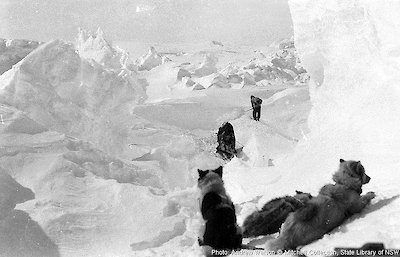The serious work begins: the Eastern Sledge Journey
Late October 1912 saw all in readiness for the big push, multi-week sledge journeys eastward and westward from the Grottoes. Wild, Kennedy and Watson were to form the Eastern party, while Jones, Dovers and Hoadley made up the Western group, leaving Harrisson and Moyes to staff the Grottoes.
But Harrisson, having found a dead snow petrel at the Hippo, was keen to re-visit the island to observe the birds during nesting. He persuaded Wild to let him accompany the Eastern party as far as the Hippo, after which he would return with the dogs to the Grottoes. Moyes agreed to remain alone at the Hut in Harrisson’s absence, expected to be less than three weeks.
It didn’t work out that way. At the Hippo the party found the depot they had deposited two months earlier had been attacked by the wind. The food bags were retrieved, but the sledge and pole had disappeared and could not be found. The loss meant Harrisson could not return to the Grottoes alone because Wild could not spare a second sledge. Wild resolved that Harrisson should stay with them. Moyes would have to endure many worrying weeks — alone, and no doubt fearing for Harrisson’s safety.
At the Hippo, Kennedy made some magnetic observations and Watson collected rocks. To his great delight, Harrisson found his nesting petrels: ‘Beautiful little things … nesting by dozens in the crevices and under the stones: the rock was alive with them and resounded with their cries, while dozens flew around.’
So on they went — to 180 metre Delay Point, from where, in Harrisson’s words, they viewed ‘great slopes and hills of ice and snow, with occasional ridges and points of rocks showing’. And beyond, ‘a great rock cliff, partly hidden by a snow slope…’, then beyond this, ‘a terminal point, crested with rock’.
Another 20 or so kilometres further on they sighted a large island, some 20 kilometres long, which was named for Mawson’s old Antarctic companion, Professor TE David — David Island. Heavily-crevassed glacier ice – a formation later named Denman Glacier, after Australia’s Governor-General – forced them northward to the island’s eastern shore.

